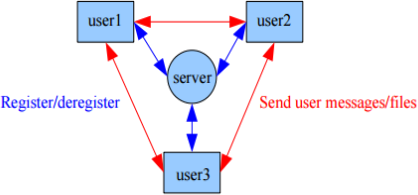Hello, if you have any need, please feel free to consult us, this is my wechat: wx91due
Data Communication and Net-centric Computing (COSC1111)
Assignment 3 (30%)
Aims: Exploration of the centralized peer-to-peer (P2P) communication app.
RMIT chat server is an open-source network platform implemented by our students guided by tutor and lecturer. It uses Java core library and has a centralized Peer-to-Peer (P2P) structure as shown in Figure 1. In this app, a central server manages the registration of peers. Once registered, peers will be able to connect to the server for locating the files they request, then reach to the peers for exchanging files without the involvement of the central server.
Ref:https://titan.csit.rmit.edu.au/~e46970/bna/

Figure 1 Centralized peer-to-peer structure of RMIT chat server.
Task 1 Using Packet Tracer v8.2.2 to set-up the network and simulate the behaviours complying with the centralized P2P structure shown in Figure 1. (10 marks)
1. Network Setup and Configuration: Set up the network, including routers, switches, and end devices such as the server and peers (PCs). Configure the server and peers communicate using TCP.
2. Verify Configuration: Verify the configuration.
3. Show the TCP Connection: Show the handshakes of server and peers.
4. Show the server function: Assume registration process is complete and sever handle incoming connections from peers and send responses with IP addresses.
5. Show the peer function: Simulate how the PING messages travel through the network.
6. Explore the TTL (Time-to-live): Inspect the packet details in the OSI mode to check the TTL values.
Show all necessary screenshots and provide step-by-step explanation to address the required points.
Task 2 Investigating congestion prevention in packet transmission. (15 marks) You need to choose one of the two options below.
Option 1 Write a technical essay in less than 4 pages using the given template (you can download the template from Assignment 3 folder) to address the congestion control in packet transmission:
• Investigate how to implement the chat between peers in the centralized P2P networks.
• Provide technical details on how the data link layer uses switch, Spanning Tree Protocol and Per VLAN Spanning Tree protocols to prevent congestion.
• Provide the technical details on why and how network layer adopts Time-to-Live (TTL) to avoid traffic congestion?
• Explore the small world model and explain how the network designers select TTL value that ensures the optimization of resource usage.
Note that You need to use Situation, Task, Action Result (STAR) model, includes
1) give a correct title to your essay, and introduce the background and task;
2) show the technical details using figures, tables, statistics, etc.; and
3) align the statements closely with the evidence provided in 2);
4) conclude your points and cite academic references.
Option 2 Create a media file, e.g., video around 5 mins, about the prevention of single- point-of-failure that compares client-server model, centralized P2P and Chord DHT:
• Show the traffic signal flow of centralized P2P, and discuss how centralized P2P differs from client-server model.
• Explain the mechanism of Distributed Hash Table (DHT). How the DHT enables decentralized, efficient, and resilient storage and retrieval of data globally.
• How the Chord DHTs ensure that each node involves in routing the request and each node forwards the request closer to the target node.
Task 3 Oral presentation (5 marks)
• Book a slot for demo between 26th June and 2nd July
• Prepare a presentation to showcase the features and capabilities of your task 2 to stakeholders and potential users.
• Each group demos 8 mins, followed by 6 mins Q/A
• Each member presents your individual contribution to the group work.